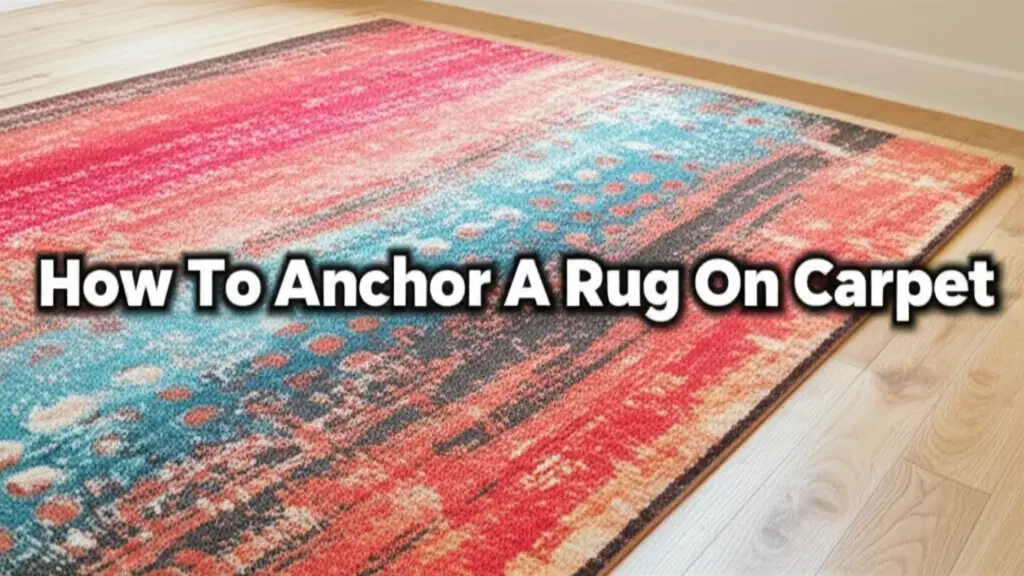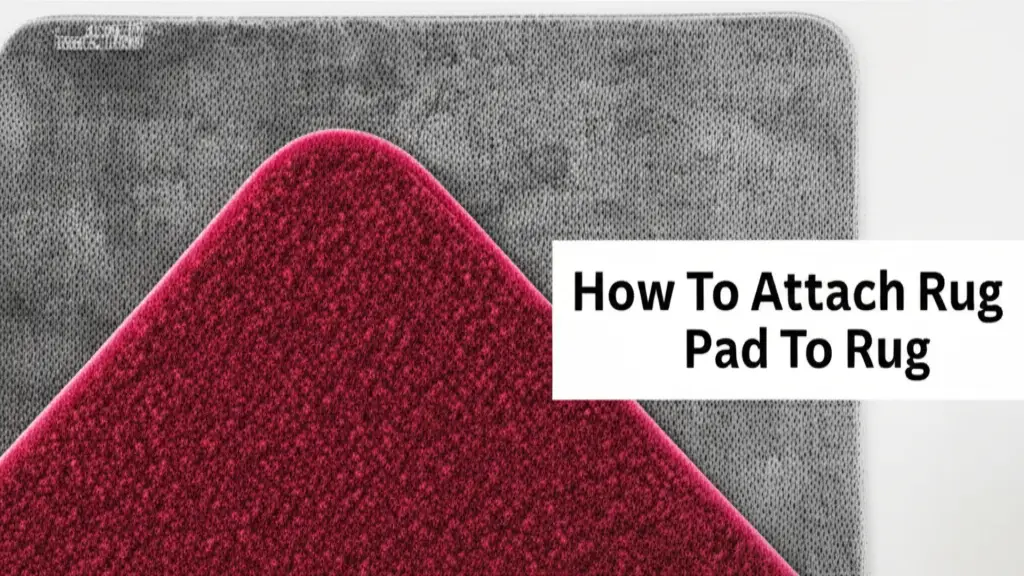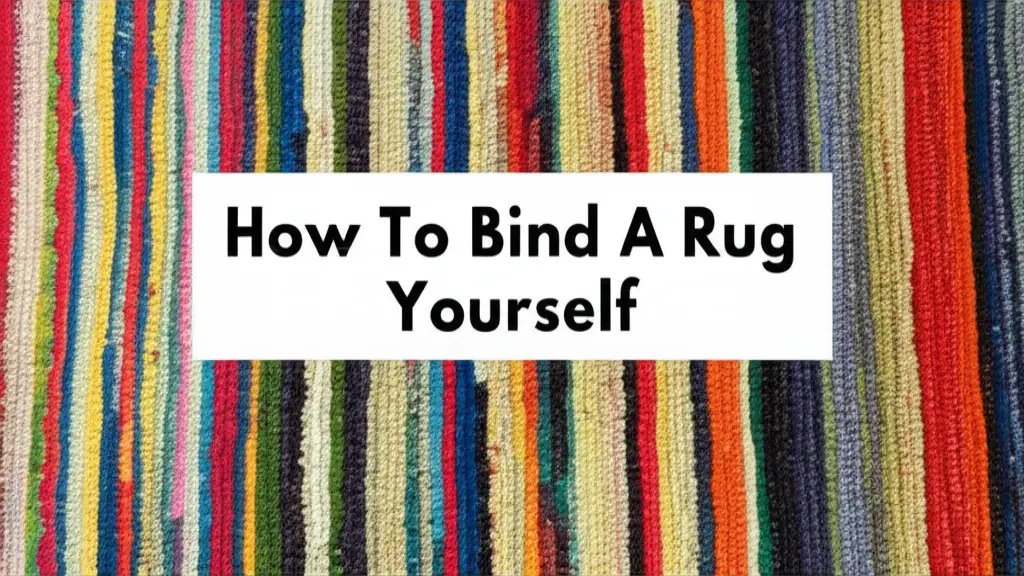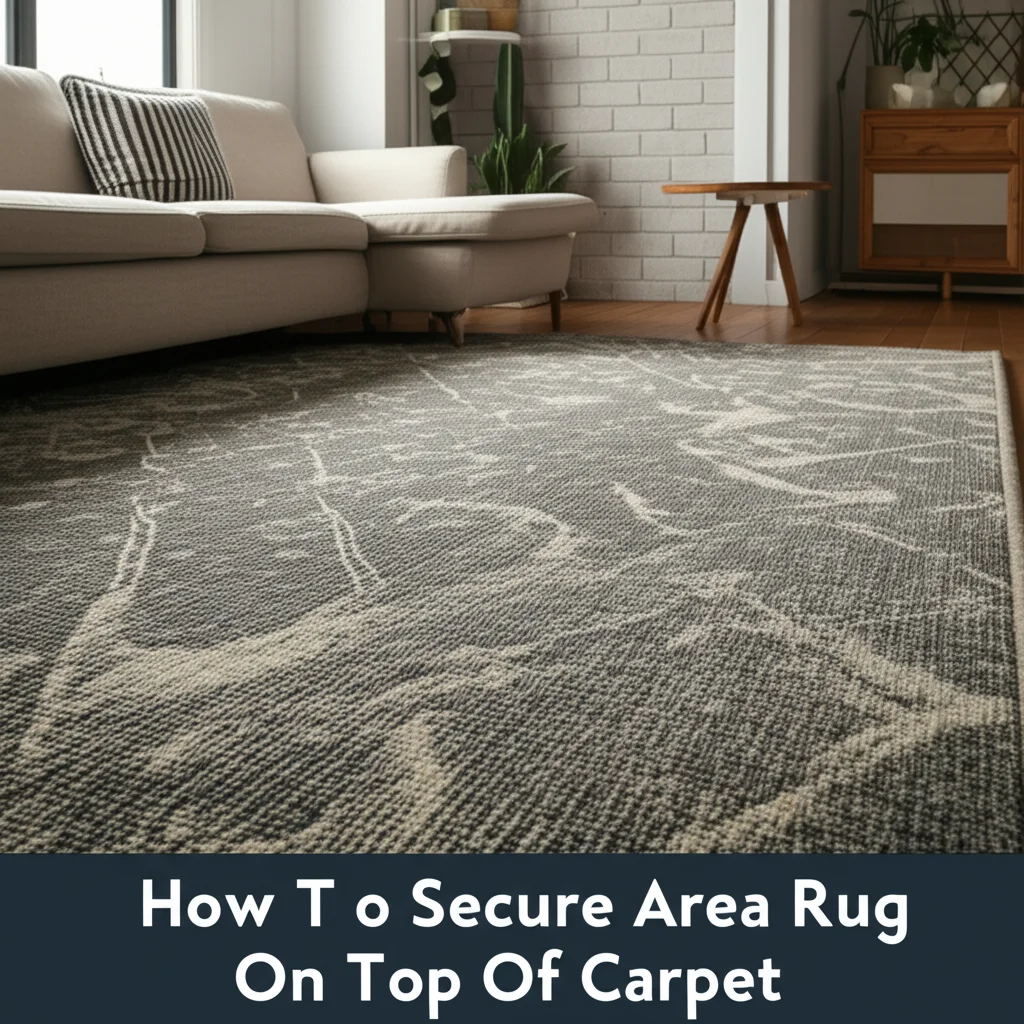· Todd Martin · Rugs · 18 min read
How To Anchor An Area Rug Over Carpet
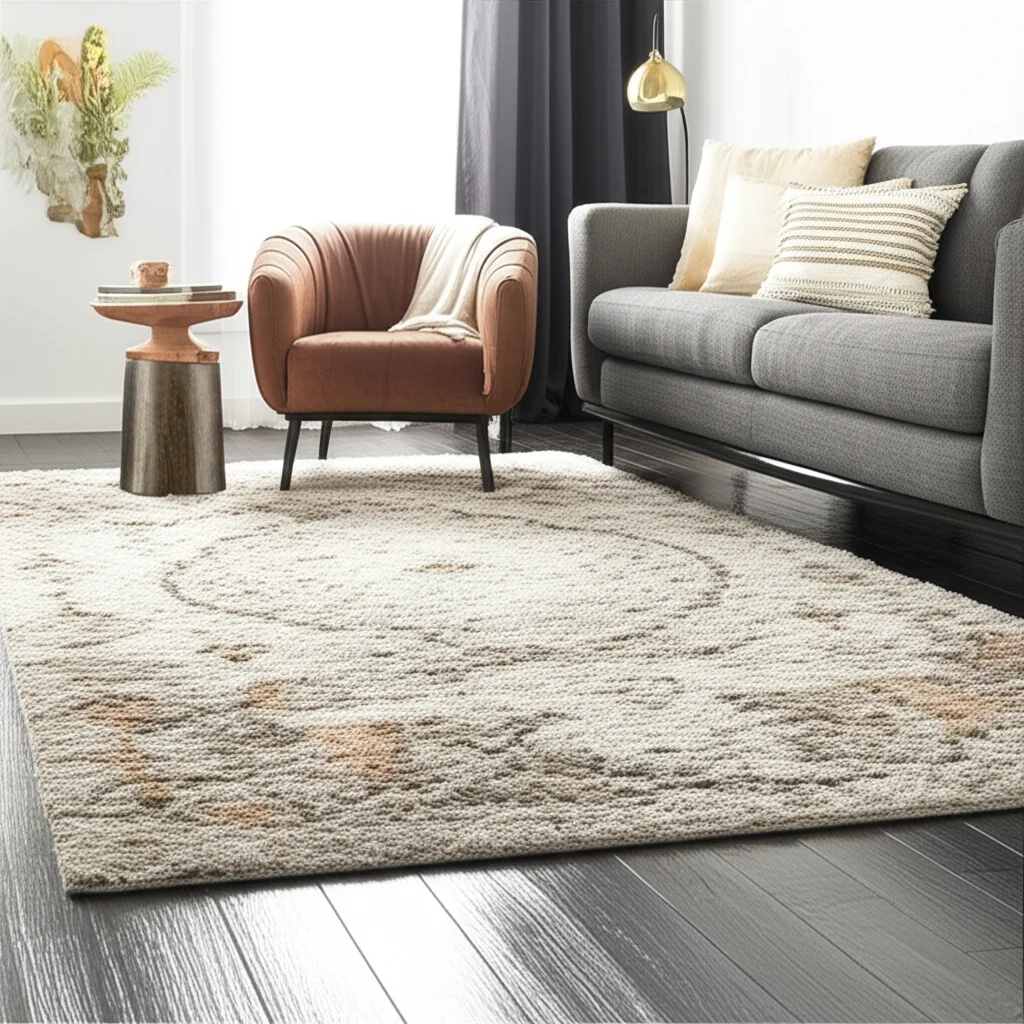
How To Anchor An Area Rug Over Carpet: 8 Simple & Effective Methods
Introduction
Adding an area rug over your existing carpet can transform a room, define spaces, and introduce texture, color, and personality to your home decor. However, placing a rug on top of carpet presents a unique challenge: keeping it firmly in place. Without proper anchoring, rugs can bunch up, slide, or create tripping hazards. Whether you’re looking to enhance your living room, bedroom, or any carpeted space, knowing how to anchor an area rug over carpet is essential for both safety and aesthetics. In this comprehensive guide, we’ll explore various effective methods to secure your area rug on carpet, ensuring it stays put while maintaining your room’s stylish appearance.
Key Takeaways
- Double-sided carpet tape is the most popular method for anchoring area rugs to carpet
- Rug grippers and non-slip rug pads are effective alternatives that won’t damage your carpet
- Claw pins and silicone caulk offer more permanent anchoring solutions
- Furniture placement can naturally secure your rug without additional products
- Regular repositioning and maintenance help extend the life of both your rug and carpet
In a nutshell: To anchor an area rug over carpet, use double-sided carpet tape along the edges and corners, place non-slip rug pads underneath, use rug grippers, or strategically position heavy furniture to keep the rug in place without damaging the underlying carpet.
Why Put an Area Rug Over Carpet?
Before diving into anchoring methods, you might wonder: “Is it dumb to put a rug over carpet?” Not at all! There are numerous practical and aesthetic reasons for layering rugs over carpet.
Area rugs can define specific zones within a larger space, especially in open-concept homes or spacious rooms. They add visual interest through colors, patterns, and textures that might be missing from your wall-to-wall carpeting. For renters who can’t replace existing carpet, area rugs offer a temporary way to transform the look of a room without permanent changes.
Area rugs also provide additional protection to high-traffic carpet areas, extending the life of your underlying carpet. The extra layer can offer more cushioning and comfort underfoot, particularly important in play areas or rooms where you spend a lot of time standing.
From a design perspective, area rugs over carpet can:
- Add personality to neutral carpeting
- Introduce seasonal changes to your decor
- Define separate functional areas within larger rooms
- Cover stains or worn patches on existing carpet
- Add warmth and coziness to a space
However, without proper anchoring, these benefits can be overshadowed by constantly shifting rugs and potential tripping hazards. Let’s explore how to properly secure your area rug to enjoy these advantages safely.
Method 1: Double-Sided Carpet Tape
Double-sided carpet tape is perhaps the most popular and straightforward solution for anchoring area rugs over carpet. This specialized adhesive tape is designed to secure rugs without damaging the underlying carpet fibers.
How to Apply Double-Sided Carpet Tape:
- Clean both surfaces to remove dust and debris.
- Measure and cut strips of double-sided carpet tape to fit along the perimeter of your rug.
- Apply the tape approximately 1-2 inches from the edge on the underside of your area rug.
- Remove the protective backing from the exposed side of the tape.
- Carefully position your rug and press down firmly along the edges to activate the adhesive.
For larger rugs, consider adding strips of tape in a grid pattern across the middle section for additional security. This creates multiple anchor points that prevent the center from bubbling up or shifting.
When shopping for double-sided carpet tape, look for products specifically designed for carpet-to-rug applications. These tapes provide sufficient adhesion without leaving residue on your carpet when removed. Some premium options feature residue-free removal and are designed to be gentle on all carpet types.
Double-sided carpet tape works exceptionally well on low to medium-pile carpets. For high-pile carpets, you might need to combine this method with others for optimal results.
One significant advantage of double-sided carpet tape is its invisibility once installed. Unlike some other methods, tape doesn’t create visible bumps or alter the appearance of your rug.
Method 2: Non-Slip Rug Pads
Non-slip rug pads offer a less adhesive-dependent approach to securing area rugs over carpet. These specially designed pads sit between your area rug and the underlying carpet, creating friction that helps keep everything in place.
Benefits of Non-Slip Rug Pads:
- Adds cushioning and comfort underfoot
- Protects both the rug and carpet from wear
- Improves air circulation between layers
- Easily trimmed to fit any rug size
- Completely reversible and repositionable
When selecting a non-slip rug pad for carpet, look for options specifically designed for carpet-to-rug use. These differ from hardwood or tile rug pads as they feature different textures and materials optimized for gripping carpet fibers.
Most quality non-slip pads for carpet use PVC, natural rubber, or felt-rubber combinations. The rubber components grip the carpet while felt surfaces protect your area rug’s backing. For eco-conscious homeowners, there are also plant-based and recycled material options available.
To install a non-slip rug pad:
- Select a pad slightly smaller than your area rug (1-2 inches from the edges)
- Place the pad on your carpet with the appropriate side facing up
- Position your area rug carefully over the pad
- Smooth out any wrinkles or bubbles in both the pad and rug
For optimal results, combine a non-slip pad with strategic furniture placement, especially in high-traffic areas or rooms where children and pets play.
One significant advantage of non-slip pads is their ease of cleaning and maintenance. Most can be vacuumed or washed periodically to remove dust and debris that might otherwise accumulate between your carpet and area rug.
Method 3: Rug Grippers
Rug grippers offer another excellent solution for securing area rugs on top of carpet. These small, discrete devices are designed specifically to prevent rugs from sliding and bunching up while being easy to install and remove.
Types of Rug Grippers:
- Corner grippers: These triangular or circular pads attach to each corner of your rug.
- Edge grippers: Placed along the perimeter of the rug for more comprehensive coverage.
- Adhesive grippers: Use mild adhesive to stick to the rug backing.
- Non-adhesive grippers: Use rubber or silicone materials that create friction without adhesives.
The main advantages of rug grippers include their discrete profile (they’re virtually invisible once installed) and their non-damaging nature. Most quality grippers won’t leave residue on your carpet or damage the fibers of either surface.
To install rug grippers:
- Clean the underside of your area rug to ensure good adhesion.
- Place grippers at each corner, approximately 2-3 inches from the edges.
- For larger rugs, add additional grippers every 2-3 feet along the perimeter.
- Press firmly to ensure proper attachment.
- Place the rug in your desired position and press down to activate the gripping mechanism.
Rug grippers are particularly effective for medium to high-pile carpets where other methods might not provide sufficient stability. They’re also an excellent option for households with children and pets, as they provide strong anchoring without chemicals or adhesives that might be concerning for sensitive individuals.
For maximum effectiveness, consider combining rug grippers with a lightweight non-slip pad for larger area rugs. This dual approach provides both perimeter and center stability.
Method 4: Claw Pins and Anchor Systems
For more permanent or heavy-duty applications, claw pins and professional anchor systems offer a robust solution for securing area rugs over carpet. These mechanical fasteners physically connect your area rug to the underlying carpet, providing exceptional stability.
How Claw Pins Work:
Claw pins (sometimes called “carpet claws” or “rug anchors”) feature small plastic discs with tiny hooks or teeth that grip both the area rug and the underlying carpet. They’re inserted through the area rug and into the carpet beneath, effectively connecting the two surfaces.
To install claw pins:
- Position your area rug exactly where you want it on the carpet.
- Insert pins at each corner, approximately 1-2 inches from the edges.
- Add additional pins every 2-3 feet along the perimeter for larger rugs.
- Press firmly until the disc sits flush with the area rug surface.
The main advantage of claw pins is their exceptional holding power. Unlike adhesive methods, they create a mechanical connection that can withstand heavy furniture, high traffic, and even active pets and children. They’re particularly useful for rugs in entryways, dining rooms, and other high-activity areas.
Some considerations when using claw pins:
- They create small visible dots along your rug’s perimeter
- Removal and repositioning requires more effort than adhesive methods
- They work best with medium to high-pile area rugs that can conceal the disc heads
- They may not be suitable for valuable or antique rugs
Professional carpet installers sometimes use similar but more sophisticated anchor systems for permanent installations. These might include specialized screws designed for carpet-to-carpet applications or professional-grade hook systems.
If you’re concerned about damaging either carpet or rug, consider using removable hooks or fasteners designed specifically for this purpose, which offer a middle ground between temporary adhesives and permanent mechanical fasteners.
Method 5: Silicone Caulk Dots
A creative yet effective method for anchoring area rugs to carpet involves using clear silicone caulk to create non-slip dots on the rug’s underside. This method provides strong adhesion while remaining removable and non-damaging to both surfaces.
How to Apply Silicone Caulk Dots:
- Flip your area rug upside down on a clean surface.
- Using a caulk gun, apply small dots (about the size of a dime) of clear silicone caulk to the underside of the rug.
- Space the dots approximately 6-8 inches apart across the entire surface, with more concentrated application around the edges.
- Allow the silicone to dry completely (typically 24-48 hours) until it forms flexible, rubbery dots.
- Once dry, flip the rug over and position it on your carpet.
The silicone dots create friction against the carpet fibers without permanently bonding to them. This method works particularly well for medium to large rugs that need comprehensive anchoring across their entire surface.
Some benefits of the silicone caulk method include:
- Long-lasting grip that remains effective for months to years
- Clear silicone is invisible from the top side of the rug
- Can be removed without damaging most rug fibers or backings
- Creates an even distribution of anchoring points
- Affordable and readily available materials
For best results, use 100% silicone caulk rather than acrylic or blended products, as pure silicone offers better flexibility and durability without hardening completely. Clear silicone is preferable to avoid any potential discoloration of light-colored rug backings.
This method is particularly useful for oddly shaped rugs or situations where you need customized anchoring patterns. However, it’s not recommended for valuable or antique rugs due to the potential for the silicone to bond with natural fiber backings over time.
Method 6: Strategic Furniture Placement
One of the most natural and non-invasive ways to anchor a rug on carpet is through strategic furniture placement. This method uses the weight of your furniture to naturally hold the area rug in position without requiring adhesives or mechanical fasteners.
Effective Furniture Placement Strategies:
- Frame the rug with furniture: Position larger pieces like sofas and armchairs so their front legs rest on the rug while back legs remain on the carpet.
- Center anchoring: Place coffee tables, ottomans, or other heavy pieces near the center of the rug to prevent buckling.
- Corner weighting: Position smaller furniture pieces like side tables at the corners of the rug to prevent edge curling.
- Distributed weight: Ensure weight is evenly distributed across the rug rather than concentrated in one area.
This method works particularly well in living rooms where substantial furniture naturally defines the seating area. The ideal scenario is to have furniture contact points around the entire perimeter of the rug, effectively “pinning” it in place from multiple directions.
For dining rooms, ensure the table and all chairs (even when pulled out) remain on the area rug. This prevents the chairs from catching the rug edge when moved, which can cause bunching and tripping hazards.
Some benefits of the furniture anchoring approach:
- No chemicals, adhesives, or mechanical devices required
- Preserves the condition of both the area rug and carpet
- Creates a visually cohesive room layout
- Easy to adjust or reposition as needed
- Ideal for renters or temporary placements
While furniture placement alone may be sufficient in low-traffic areas, consider combining this method with one of the previously mentioned techniques in high-traffic spaces or for smaller accent rugs that don’t have furniture on them.
Method 7: Velcro Strips
Velcro strips represent another versatile option for securing area rugs over carpet, offering strong hold with the flexibility of easy removal and repositioning. This method uses adhesive-backed hook and loop fasteners to create a strong connection between your area rug and the underlying carpet.
How to Use Velcro for Rug Anchoring:
- Purchase adhesive-backed Velcro strips designed for fabric or carpet applications.
- Cut strips to the desired length (typically 3-6 inches).
- Attach the “hook” side of the Velcro to the underside of your area rug corners and edges.
- Attach the corresponding “loop” pieces to the same positions on your carpet.
- Press the rug in place, allowing the Velcro pieces to connect.
For larger rugs, place additional Velcro strips every 1-2 feet along the perimeter and in an X-pattern across the center for maximum stability. The beauty of this system is that it creates a strong hold while still allowing you to easily separate the surfaces when needed.
This method works particularly well for homes with children or pets, as the strong Velcro connection can withstand running, playing, and other activities that might shift a rug. It’s also excellent for high-traffic areas like hallways and entryways.
Some considerations when using Velcro strips:
- Choose heavy-duty, wide Velcro designed specifically for carpet applications
- Test the adhesive on a small, inconspicuous area of both surfaces first
- Higher-quality Velcro typically provides stronger holding power
- Consider sewing the Velcro to valuable rugs rather than using adhesive
- Some adhesive Velcro may leave residue when removed
For a more permanent installation, consider having a professional sew Velcro strips to your area rug and use the corresponding adhesive pieces on your carpet. This provides maximum holding power without risking damage to the rug from adhesives.
Method 8: Rug-on-Carpet Tape Systems
For those looking for professional-grade solutions, specialized rug-on-carpet tape systems offer comprehensive anchoring for even the most challenging situations. These systems are designed specifically for the unique challenges of securing one carpet surface to another.
Professional Tape System Components:
- Perimeter tape: Specialized double-sided tape designed for the outer edges of the rug
- Center grid tape: Lighter adhesive strips for the interior sections
- Corner anchors: Reinforced adhesive pieces for high-stress corner areas
- Residue remover: Solutions for clean removal when repositioning
These comprehensive systems often include different types of adhesives optimized for different parts of the rug. Stronger adhesives are used at corners and edges, while gentler formulations are used for center areas where less shifting occurs.
To install a professional tape system:
- Clean both the rug backing and carpet surface thoroughly.
- Apply the perimeter tape following the manufacturer’s spacing guidelines.
- Create a grid pattern with the center tape, typically in 1-2 foot intervals.
- Apply reinforced corner pieces to each corner.
- Remove the protective backing and carefully position the rug.
- Press firmly across the entire surface to activate the adhesive bonds.
Professional systems typically offer superior holding power compared to generic double-sided tape while still being designed for eventual clean removal. Many include special release agents that break down the adhesive bond without damaging either surface.
These systems are particularly valuable for commercial spaces, rental properties, staging homes for sale, or any situation where absolute stability is required without permanent installation. While more expensive than simpler solutions, they offer comprehensive coverage and professional-grade performance.
Tips for Choosing the Right Anchoring Method
With so many options available, selecting the right method to secure your area rug on carpet depends on several factors. Consider these aspects when deciding which anchoring approach is best for your specific situation:
Room Usage and Traffic Level
- High-traffic areas (entryways, hallways): Choose mechanical fasteners, comprehensive tape systems, or Velcro for maximum stability.
- Medium-traffic areas (living rooms, dining rooms): Non-slip pads combined with furniture anchoring often suffice.
- Low-traffic areas (guest rooms, formal spaces): Simple corner grippers or furniture anchoring may be adequate.
Rug Size and Weight
- Small accent rugs (under 4×6 feet): Corner grippers, double-sided tape, or silicone dots work well.
- Medium rugs (5×8 to 8×10 feet): Non-slip pads, perimeter tape, or Velcro strips provide good balance.
- Large rugs (9×12 feet and larger): Combine furniture anchoring with strategic non-slip pad placement.
Household Considerations
- Homes with children: Prioritize methods with no exposed sharp edges or chemicals.
- Pet-friendly homes: Choose solutions that withstand scratching and pet movement.
- Rental properties: Select removable options that won’t damage the underlying carpet.
- Temporary placements: Opt for non-adhesive methods like furniture anchoring or removable grippers.
Rug and Carpet Types
- Valuable or antique rugs: Avoid adhesives; use non-slip pads or gentle corner grippers.
- Low-pile carpet with low-pile rugs: Double-sided tape or thin non-slip pads work best.
- High-pile carpet with thicker rugs: Mechanical fasteners or specialized high-pile rug pads are more effective.
Installation Preference
- DIY-friendly: Double-sided tape, non-slip pads, and furniture placement are easiest to implement.
- Professional-level stability: Claw pins, comprehensive tape systems, or custom solutions may require more effort but offer superior results.
By considering these factors, you can identify the anchoring method or combination of techniques that will work best for your specific situation, ensuring your area rug stays securely in place while preserving both surfaces.
Maintenance Tips for Area Rugs Over Carpet
Properly maintaining your area rug and the carpet beneath it will extend the life of both surfaces and help keep your anchoring methods working effectively. Follow these maintenance tips for the best long-term results:
Regular Cleaning and Care
- Vacuum both the area rug and surrounding carpet weekly to prevent debris from accumulating between layers.
- Address spills immediately to prevent liquid from seeping through to the underlying carpet.
- Periodically lift the corners of your area rug to vacuum underneath, removing dust and debris that might affect grip.
- Follow the specific cleaning recommendations for your area rug material (wool, synthetic, natural fibers, etc.).
Repositioning and Re-anchoring
- Every 3-6 months, completely remove the area rug, clean both surfaces thoroughly, and reapply your anchoring method.
- Rotate your area rug 180 degrees when repositioning to ensure even wear patterns.
- Inspect adhesives, grippers, or mechanical fasteners for signs of wear and replace as needed.
- Check for any damage to either the rug or carpet that might affect stability.
Seasonal Considerations
- In humid summer months, monitor for moisture buildup between layers and ensure adequate air circulation.
- During dry winter months, static electricity can affect some anchoring methods; consider using anti-static treatments.
- Seasonal home temperature changes can affect adhesives; check anchoring after significant temperature shifts.
Professional Maintenance
- Have area rugs professionally cleaned every 1-2 years, depending on traffic and usage.
- Consider professional re-stretching of the underlying carpet if it has developed wrinkles or buckles that affect rug stability.
- Consult with carpet professionals when using area rugs over new carpet installations, as some warranties have specific requirements.
By maintaining both your area rug and the underlying carpet, you’ll create a more stable foundation for your anchoring method while preserving the appearance and longevity of both textile investments.
FAQ: Common Questions About Anchoring Area Rugs Over Carpet
Can you put an area rug over carpeting?
Yes, you absolutely can place area rugs over wall-to-wall carpeting. This design approach adds visual interest, defines spaces within larger rooms, and allows you to introduce color and pattern to basic carpeting. The key is proper anchoring to prevent slipping and tripping hazards.
How do you secure area rug on top of carpet?
The most effective methods include using double-sided carpet tape along the perimeter, placing non-slip rug pads between the surfaces, installing rug grippers at the corners, using silicone caulk dots on the rug backing, or strategically positioning furniture to hold the rug in place.
How do you get a rug to sit flat on carpet?
Start by purchasing a quality rug pad specifically designed for carpet-to-rug use. Before placing your rug, vacuum the carpet thoroughly and ensure both surfaces are clean and dry. Use corner weights or furniture to hold the rug flat for 24-48 hours, allowing it to settle. For persistent curling edges, try reverse-rolling the rug overnight.
Can you screw a rug to carpet?
While not conventional, specialized carpet screws or claw pins do exist for securing area rugs to carpeting in high-traffic commercial environments. These devices physically connect both surfaces for maximum stability. However, they create small holes in the rug and should only be used where appropriate for both surfaces.
Is it better to use rug tape or rug pads on carpet?
Both have different advantages. Rug tape provides stronger anchoring along the perimeter and is virtually invisible, making it ideal for high-traffic areas. Rug pads offer full-surface cushioning, improve air circulation, and are easily repositioned without adhesives. The best approach often combines both: a non-slip pad for overall stability with tape at high-movement areas like corners.
How do I prevent my area rug from bunching up on carpet?
Bunching typically occurs from furniture movement or high foot traffic. Prevent this by using a combination of anchoring methods: non-slip pad underneath, double-sided tape at the corners, and strategic furniture placement. For severe bunching issues, consider professional-grade anchoring systems or mechanical fasteners at key points.
Will anchoring damage my carpet or area rug?
When used correctly, most anchoring methods won’t damage either surface. Choose products specifically designed for carpet-to-rug applications, test in inconspicuous areas first, and follow manufacturer instructions. Adhesive products generally pose the greatest potential for damage, while non-slip pads and furniture anchoring are gentlest on both surfaces.
Final Words
Anchoring an area rug over carpet doesn’t have to be a frustrating experience. With the right techniques and materials, you can successfully layer rugs over carpet to enhance your home’s style while maintaining safety and stability. Whether you opt for the simplicity of double-sided tape, the comprehensive coverage of non-slip pads, or the natural anchoring of strategic furniture placement, the key is selecting the method that best suits your specific situation.
Remember that different rooms and usage patterns may require different approaches. Don’t hesitate to combine multiple methods for optimal results, particularly in high-traffic areas or homes with children and pets. Regular maintenance of both your area rug and the underlying carpet will extend the life of your anchoring solution and keep your layered floor coverings looking their best.
By properly securing your area rugs over carpet, you can confidently enjoy the design versatility, added comfort, and personalized style that this decorating approach offers. Transform your carpeted spaces with beautiful area rugs that stay exactly where you put them, creating defined, stylish areas throughout your home.


